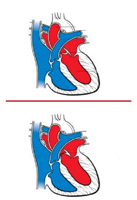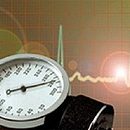Aortic valve stenosis is a narrowing of the hole between the left ventricle and aorta. The narrowing significantly complicates the blood flow in the aorta, as a result, the ventricle must be reduced with great effort. Decompensation of vice leads to the appearance of cardiac asthma.
Content
The mechanism of development of aortic stenosis
 The largest vessel of the human body - aorta comes out of the left ventricle of the heart. It carries arterial blood from the heart under high pressure, provided with a reduction in the powerful muscle of the left ventricle. Further on systems of large and small arteries and arterioles rich in oxygen blood reaches each body cell. The heart pumped the heart in the systole phase and in order to relax the ventricle, in the diastole phase, when the pressure in the left ventricle falls, the blood did not return to the gastroincing cavity, the aortic valve is at the entrance to the aorta. It consists of three seaside flaps.
The largest vessel of the human body - aorta comes out of the left ventricle of the heart. It carries arterial blood from the heart under high pressure, provided with a reduction in the powerful muscle of the left ventricle. Further on systems of large and small arteries and arterioles rich in oxygen blood reaches each body cell. The heart pumped the heart in the systole phase and in order to relax the ventricle, in the diastole phase, when the pressure in the left ventricle falls, the blood did not return to the gastroincing cavity, the aortic valve is at the entrance to the aorta. It consists of three seaside flaps.
With rheumatic and other heart disease, the sash can thicken and grow together with each other, scars are formed on them. In this state, the sash is not capable of full disclosure. At the same time, their function is broken, and the entrance to the aorta narrows. The narrowing of the entrance to the aorta makes it difficult to empty the left ventricle. More effort is required to push the blood in the aorta and the left ventricle due to the high load thickens. At the same time, the very pronounced hypertrophy of the heart muscle arises. Since the muscle of the left ventricle is powerful, the vice for a long time can leak imperceptibly for the patient.
However, over time, compensatory reserves of the muscles of the left ventricle are depleted. This contributes to the insufficiency of the blood supply to the heart muscle, which arises due to the inconsistency of the need for increased muscle in oxygen and its delivery vessels of the heart. The left ventricle is stretched, the dimensions of its inner cavity increase, at the same time it stretches and the mitral valve, which leads to the occurrence of deficiency of the mitral valve and the reverse current of the blood of the left ventricle into the left atrium. Pressure in the lung vessels increases, gas exchange is broken into the lungs, which further worsens the nutrition of the heart muscle.
Symptoms of the disease
The patient with the stenosis of the aorta complains of heartbeat, pain in the heart, chest pain, pain in the chest. Often, these pains have a compressive character, as when attacking angina. Dizziness occurs, faint. First, when loaded, then shortness of breath appears. When decompensing a vice, a hearty asthma occurs. The patient complains of cough with a small amount of sputum. Sometimes there may be a hemlashing, there may be swelling of the lungs. Patient is usually paled. He may have a noticeable pulsation in the heart. When feeling you can determine the jitter of the chest.
Diagnosis of aortic stenosis
Rough Systolic noise is heard from the sternum. This noise can be heard on the neck vessels. The radiograph shows an increase in the size of the left ventricle of the heart, usually rounded shape. On the electrocardiogram - an increase in left ventricle. Echocardiography allows you to see the change in the structure of the aortic valve, to establish the degree of reduction of the opening from the left ventricle in the aorta, the volume of blood emitted by the ventricle.
Methods for the treatment of aortic valve stenosis
Medical treatment of aortic stenosis is reduced to the treatment of the main disease, if it is detected on time. In later stages, this treatment of heart failure.
Surgical treatment of aortic stenosis is one of the main methods of treatment. Dissection of intoxicated flaps of the aortic valve inefficient. It gives bad remote results and can only be carried out in children in the absence of rough changes of the valve flaps. Therefore, the prosthetics of the aortic valve is performed through incision in the wall of the aorta.









